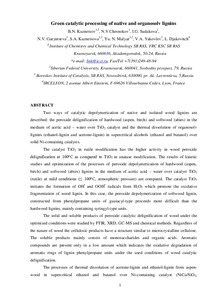Показать сокращенную информацию
Green catalytic processing of native and organosolv lignins
| Автор | Kuznetsov, B. N. | |
| Автор | Chesnokov, N. V. | |
| Автор | Sudakova, I. G. | |
| Автор | Garyntseva, N. V. | |
| Автор | Kuznetsova, S. A. | |
| Автор | Malyar, Yu. N. | |
| Автор | Yakovlev, V. A. | |
| Автор | Djakovitch, L. | |
| Дата внесения | 2019-07-01T07:26:33Z | |
| Дата, когда ресурс стал доступен | 2019-07-01T07:26:33Z | |
| Дата публикации | 2018-07 | |
| Библиографическое описание | Kuznetsov, B. N. Green catalytic processing of native and organosolv lignins [Текст] / B. N. Kuznetsov, N. V. Chesnokov, I. G. Sudakova, N. V. Garyntseva, S. A. Kuznetsova, Yu. N. Malyar, V. A. Yakovlev, L. Djakovitch // Catalysis Today. — 2018. — Т. 309. — С. 18-30 | |
| ISSN | 09205861 | |
| URI (для ссылок/цитирований) | https://www.sciencedirect.com/science/article/pii/S0920586117308155 | |
| URI (для ссылок/цитирований) | https://elib.sfu-kras.ru/handle/2311/110783 | |
| Аннотация | Two ways of catalytic depolymerization of native and isolated wood lignins are described: the peroxide delignification of hardwood (aspen, birch) and softwood (abies) in the medium of acetic acid – water over TiO2 catalyst and the thermal dissolution of organosolv lignins (ethanol-lignin and acetone-lignin) in supercritical alcohols (ethanol and butanol) over solid Ni-containing catalysts. The catalyst TiO2 in rutile modification has the higher activity in wood peroxide delignification at 100°C as compared to TiO2 in anatase modification. The results of kinetic studies and optimization of the processes of peroxide depolymerization of hardwood (aspen, birch) and softwood (abies) lignins in the medium of acetic acid – water over catalyst TiO2 (rutile) at mild conditions (≤ 100°C, atmospheric pressure) are compared. The catalyst TiO2 initiates the formation of OH• and OOH• radicals from H2O2 which promote the oxidative fragmentation of wood lignin. In this case, the peroxide depolymerization of softwood lignin, constructed from phenylpropane units of guaiacyl-type proceeds more difficult than the hardwood lignins, mainly containing syringyl-type units. The solid and soluble products of peroxide catalytic delignification of wood under the optimized conditions were studied by FTIR, XRD, GC-MS and chemical methods. Regardless of the nature of wood the cellulosic products have a structure similar to microcrystalline cellulose. The soluble products mainly consist of monosaccharides and organic acids. Aromatic compounds are present only in a low amount which indicates the oxidative degradation of aromatic rings of lignin phenylpropane units under the used conditions of wood catalytic delignification. The processes of thermal dissolution of acetone-lignin and ethanol-lignin from aspen-wood in supercritical ethanol and butanol over Ni-containing catalyst (NiCu/SiO2, NiCuMo/SiO2) are compared. The composition, structure and thermal properties of organosolv lignins were studied with the use of FTIR, GPC, 1H - 13C HSQC NMR, DTA and elemental analysis. The influence of a composition of Ni-containing catalyst on the thermal conversion in supercritical butanol and ethanol of ethanol-lignin and acetone-lignin was established. The highest conversion of lignins (to 93% wt.) in supercritical alcohols and the highest yield of liquid products (to 90 % wt.) were achieved at 300 °C in the presence of catalyst NiCuMo/SiO2. Scheme of green biorefinery of wood based on the use of non-toxic and low-toxic reagents (H2O2, H2O, acetic acid, ethanol, butanol) and solid catalysts (TiO2, NiCuMo/SiO2) is suggested. | |
| Тема | lignin | |
| Тема | depolymerization | |
| Тема | catalysts | |
| Тема | bio-liquids | |
| Название | Green catalytic processing of native and organosolv lignins | |
| Тип | Journal Article | |
| Тип | Journal Article Preprint | |
| Страницы | 18-30 | |
| ГРНТИ | 31.21 | |
| Дата обновления | 2019-07-01T07:26:33Z | |
| DOI | 10.1016/j.cattod.2017.11.036 | |
| Институт | Институт цветных металлов и материаловедения | |
| Подразделение | Кафедра органической и аналитической химии | |
| Журнал | Catalysis Today | |
| Квартиль журнала в Scopus | Q1 | |
| Квартиль журнала в Web of Science | Q1 |

